12 Marzo 2011
English
WATER AND STONE
Travertine from spa to bathroom
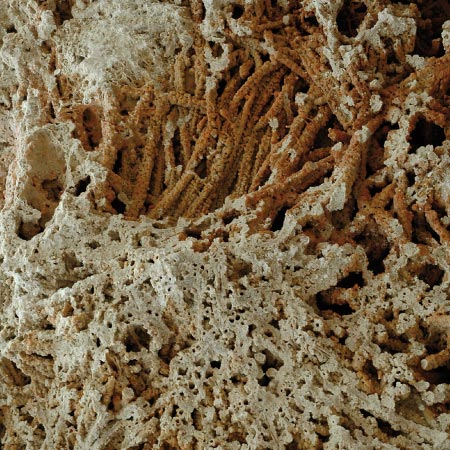
Limestone concretions formed by flowing thermal waters.
«The fact that in many quarries sulphuric waters of a bluish-white colour spring forth from the rock strengthens the perception that the stone is just a condensed liquid, the solid sediment of that river of fetid, milky fluid which the Earth produces in abundance. Only when separated from the rock face and cut into blocks, does travertine lose contact with the matrix: it becomes harder and whitens».1
The origin of the material
The fluid material deposits and then hardens into rock; in his interpretation Paolo Portoghesi perceives the intrinsic nature of travertine, a stone characterising the Roman landscape that is also historically associated with the territory of Siena, an area of spas thanks to the carbonate nature of this lithotype and its link to the flow of waters. During the process of lithogenesis, subsequent to the sedimentation of calcium carbonate present in the water, numerous gaseous inclusions form; these create the irregular porosity of this material, whose every single fragment is unique.
The inextricable link between travertine and thermal spas and, in general, between stone and water, as reflected in the world of architecture and of design for wellbeing, is the theme of this brief essay.
Water, the element originating life, a symbol not only of survival but also of sacredness, mystery and beauty, marks the origin of the Tuscan territory: an ancient and tangible relationship that delineates the actual morphology of the landscape and the characteristics of the materials which shape it. Thermal salts, which have widely acknowledged beneficial properties, before they solidify as rock, are indispensable for all those curative and aesthetic practices to which contemporary society pays ever greater attention.
The focus on the care of one’s body, particularly since the start of this millennium, is a result of the cultural evolution that occurred in the last two centuries. The current centres dedicated to wellbeing, both in the public and private sector, are the result of the gradual transformation of the customs of contemporary society. Starting in the 19th century, specific technologies and types of services and environments dedicated to personal hygiene and care of the body have been developed.
Within this context, spa culture has a prominent role; although known since ancient Roman times, spas remain the prerogative of just a few until the end of the 18th century, when they are gradually rediscovered by the upper classes and the presence of public areas dedicated to hydrotherapy increases in urban centres. These establishments, a development of public baths, help to both focus attention on care of the body and create a fashion for health resorts, later leading to the introduction of a specific room in the house dedicated to personal hygiene and aesthetic care: the bathroom.
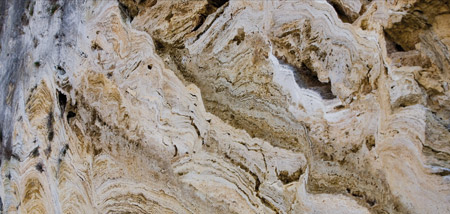
Travertine strata in the Acqua Borra thermal park near Castelnuovo Berardenga.
Nowadays the need to escape from ever more frenetic lifestyles has led to the development of spaces reserved for rituals connected to total physical and mental wellbeing, thus becoming a widespread expression of global culture. In such “regenerating environments” people search for new iconic-sensory harmonies, and architecture and design are once again the ideal means for the expression of this equilibrium. The growing importance given by modern society to a new hedonism and cult of the body is linked to the awareness of the inescapable need for sustainable development within a globalized world; this is linked to new models that enhance the value of territorial assets, both environmental and socio-cultural.2
Thanks to this relationship, developed particularly in recent years, modern society is rediscovering the value of the natural qualities of this rock and of the areas in which it forms, placing it in relationship to areas dedicated to wellbeing. The latter become silent natural temples where beneficial waters spring up among the stones. These waters have become a new “material and immaterial resource” for local economies, which focus on novel forms of territorial politics and of a tourist industry often embracing the practical ethic of sustainable use of natural resources.3
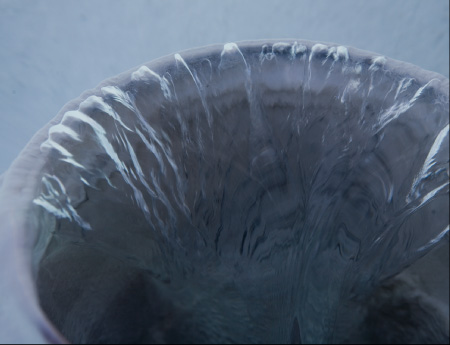
Thermal waterfalls in the San Giovanni spa in Rapolano Terme.
Space and spa architecture
In modern practice the spa environment undergoes a metamorphosis, becoming increasingly a complex, articulated area of wellbeing; likewise, the private bathroom is enriched with new spatial, material and functional connotations. The introduction of elements of design are the result of expert artisan workmanship sustained by the productive potential of the most innovative technological instruments. These changes are accompanied by new project and technological solutions, through which the stone regains its natural identity and is once again the focus of designers.
Cities host an increasing number of centres dedicated to “wellbeing” that provide a momentary respite from hectic urban life, whereas smaller places scattered throughout the territory, where the relationship with nature remains a tangible reality, now represent true modern temples of wellbeing accessible to an ever wider range of social classes.
In most cases the inextricable link between natural landscape and spa leads to the use of local stone, as seen in one of the most important examples of modern spa architecture: the Vals Spa in Switzerland designed between 1993 and 1996 by architect Peter Zumthor. Three thousand cubic meters of Valser gneiss, laid out in overlapping layers, form a compact, homogeneous monolithic volume from which the walls, pavements, pools and stairwells are derived, describing a continuous stone surface only interrupted by the aperture facing the Grison Alps. Zumthor himself believes that this spa «expresses the silent, primal experience of bathing, of relaxing in water, of bodily contact with stone and water at different temperatures in different contexts».4 A thoroughly modern interpretation of traditional architecture in the local stone of the Swiss valleys, this spa may be considered one of the most representative models of the possible dialogue between landscape and architecture, between stone and water.
Even in the Italian peninsula there is a very clear link between spa architecture and local stone. Especially in central Italy, the use of travertine widely marks this relationship. In Tuscany, evidence of spas built from this material starts in the north, at the foot of the Pistoia Apennines: the Montecatini Spa, since the 18th century a historical destination for hydrotherapy tourism. The buildings of the Leopoldine and Tettuccio spas were designed in the 1770’s by Gaspare Maria Paoletti and restructured in 1926 by Ugo Giovannozzi; they are made entirely of a local golden travertine which shapes the severe neoclassical columns, exedras, baths, fountains and walls adorned with frames and moulding. At Montecatini, along with the celebration of the smooth fluidity of this material caressed by water, its solid monumental value and precious decorations are embellished with reproductions of traditional plastic figures in ancient Roman spas.
Further south lies the “thermal heart” of Tuscany, represented by numerous sites in the Grosseto area and, more importantly in the area of Siena: at Bagni di Petriolo, Saturnia, Bagni San Filippo, Chianciano, Bagno Vignoni, San Casciano dei Bagni and, in particular, at Rapolano Terme travertine is an omnipresent material that springs forth from the earth in solidified flows, pools and natural terraces set in the landscape and modelled by the continuous flow of this liquid material. From nature to architecture: travertine, with its porosity and irregular striations that enliven its characteristic white, ochre and silver colouring, creates spaces and establishments that are now suggestive spas guaranteeing high quality services.
In Rapolano’s recently renovated spas, travertine lines without interruption the rooms and indoor tubs where treatments take place; even the buildings are covered with the local stone and, built following a criterion of minimum environmental impact, they are surrounded by warm outdoor pools that invite bathers to contemplate the surrounding gentle hilly landscape.
In these areas the massive, porous travertine stone provides a visual, tactile and auditory stimulus, its hues and its surface texture enriched by the interaction with the colour, temperature, sound and smell of the waters from which it originated; in the thermal environment, where it formed, the Sienese stone shows its adaptability to unique and particular modern applications and to a thoroughly original interior design of extremely high production quality.
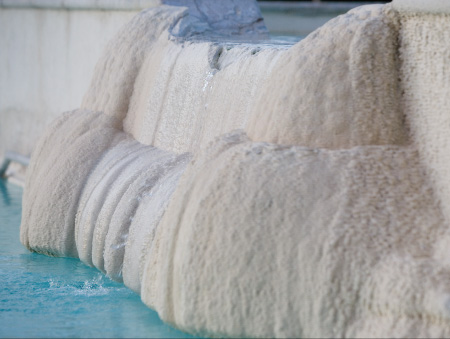
Thermal waterfalls in the Antica Querciolaia spa in Rapolano Terme.
The modern bathroom
Architecture provides continuous and renewed confirmation of the link between stone and water and of its suggestiveness; numerous fascinating works, including those not strictly linked to bodily care, demonstrate that the great masters of modern architecture have often considered this mysterious and seductive relationship, linked to the geological origins of the world, a focal point of their projects: the Barcelona Pavilion, designed by Mies van der Rohe in 1929, the extension of the Canova Plaster Cast Gallery in Possagno, designed by Carlo Scarpa between 1955 and 1957, the Salk Institute at La Jolla completed in 1959-65 and the Kimbell Museum in Forth Worth built in 1966-72, both designed by Louis I. Kahn, the Beyeler Foundation in Basle, designed by Renzo Piano in 1991, with their pools of water in stone basins, are only some of the many important examples that may be cited of the happy encounter between stone and water.5
In these works the boundary between “architectonic element” and “designer object” is nearly always blurred, if not indistinguishable. The stone is moulded into pieces of different size and shape, defining with their presence spaces, forming pools, fountains, seats, walls, pavements and raised edgings.
When considering design one must change the scale of observation and shift the focus of attention from the public realm of spa architecture to the private one of the bathroom, a room with a specific function introduced in homes only starting in the early 20th century, when it began to have a precise, rationalized layout and standard components.
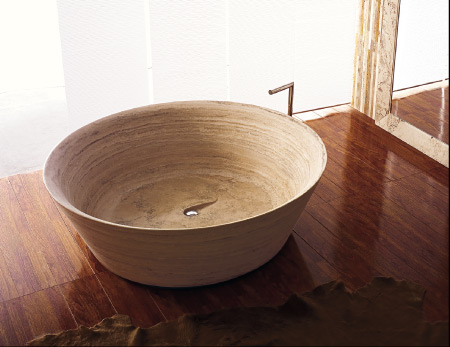
Tub in Sienese travertine designed by Studio Padrini.
With respect to more conventional and economic materials, the use of this stone in private bathrooms has always been a synonym of wealth and prestige: starting in the Roman Imperial Age, the stone was used to line the vertical and horizontal surfaces of bathrooms in important Patrician homes, and in modern times, to create original, unique components for personal hygiene and care of the body. Between the end of the 19th century and the start of the 20th century Adolf Loos and Josef Hoffmann designed bathrooms decorated with precious marble slabs for their wealthy clients, transforming these rooms into refined, luxurious spaces for the exclusive use of the homeowner.
In 1903, Viennese psychiatrist Theodor Beer commissions Loos to restructure his villa on Lake Geneva, La Maladaire. For the extension and internal restructuring of the building, later named Villa Karma, the architect decides to decorate a bathroom with black marble and white plaster, turning it into one of the most monumental environments of the home, a true temple of personal pleasure and of care for the body. The large rectangular room develops lengthwise through the juxtaposition of two areas at different levels, differentiated by tetrastyle Doric columns. The walls are lined with slabs of heavily veined black marble set, mirror-like, in a raised frame. Above, the marble gives way to the neutral surface of the white plaster fashioned into a barrel arch. The room seems to have been dug from a marble block, out of which Loos fashions the masonry shell, the columns, the curved washbasins, and the quadrangular tubs.
The bathroom designed by Josef Hoffmann for the Stoclet Palace, built in Brussels between 1905 and 1911, is also lined with prestigious stone materials. The bathroom becomes a precious casket; an intimate space of thirty-four square meters dedicated to the wellbeing of the owner. The room is a stereometrically defined volume transformed, thanks to the stone panelling, into a pavilion of “petrified cloth” resting on a pool of water. The room is delimited by the large rectangular panels of statuary white marble with grey veining, small square polychrome mosaic inserts, malachite decorations and rectilinear borders in black marble. Metaphors of hanging, juxtaposed sheets, the panels are surmounted by a second strip of textile connotation, a tapestry with raised vertical stripes that covers the upper portion of the walls. The function of the room leads Hoffmann to emphasize its symbolic implications, for which, besides the careful selection of materials, he studiedly plays with the relationship between wall and floor. The latter is covered with dark blue Belgian marble, almost in an attempt to dematerialize the floor, thus transforming it into a water surface from which the room emerges and creating another secluded, precious sanctuary in which to complete the rituals of the care of the body. The depth of the water cannot be understood, but walls and furnishings seem to be immersed in it; their bases are almost “cut”, as suggested by the lack of a frame where the panels meet the floor.
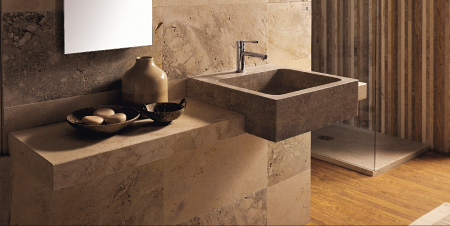
Washbasin in Sienese travertine designed by Studio Padrini.
The tub and washbasins are the protagonists of the bathroom in the Stoclet Palace; the tub stands at the centre, a majestic presence that dominates the room. While in Villa Karma the two tubs were nearly hidden by a dividing screen, here the imposing solid mass of white marble invades the space, abandoning its traditional position parallel to the wall, to be placed perpendicularly, so that it is projected towards the centre of the room. It is a parallelepiped cut at the base by the floor; the inner surface of the tub has a sinuous, smooth shape, as though it had been sculpted by water. The monolith, reflected in the dark, shiny floor surface, faces the source of light from the windows that give onto the garden.
Starting from these highly elite and luxurious reference examples, throughout the 20th century, wealthy upper class homes had large rooms with precious stone panelling and furnished with washbasins and tubs dug in blocks of stone.
French designers such as Pierre Chareau, in the 1920’s, and Emile-Jacques Ruhlmann, in the 1930s, create dream bathrooms in which the use of stone is purely an ostentation of wealth and for the personal pleasure of the client; starting in the 1940’s, the use of stone in bathroom design begins to have different connotations, with a gradual return to the values of naturalism and tradition.
Between 1939 and 1942 Adalberto Libera designs a fascinating and original home for writer Curzio Malaparte on a promontory of the Island of Capri. Malaparte writes: «it seemed clear from the start that not only the line of the house, its architecture, but also the materials with which it was to be built would have to fit in with the wild and delicate natural surroundings. Not bricks, not cement, but stone and only that local stone which makes up the promontory».6 Even the interior design is essentially based on the use of stone, which in the bathroom, besides referring to the material identity of the site, may be interpreted as a symbol of classicism and a means for revisiting the Roman thermal bath in a domestic context. The room has walls which are lined for three-quarters of their height with wide marble panels, with the veining placed vertically according to a design that Malaparte studies together with Capri painter Raffaello Castello. On one of the longer sides, a wall creates a niche surmounted by a vault with a low arch; below it the floor is dug out in the shape of a tub lined with the same material and with a marked border of white marble.
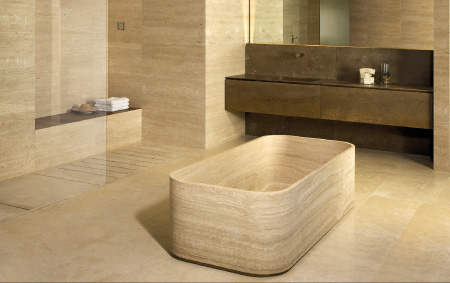
Bathroom in Sienese travertine designed by Studio Gargano Fagioli.
The marble bathroom designed by Carlo Scarpa for Casa Ottolenghi at Bardolino, on Lake Garda, dates to the 1970’s. The room develops as a semi-cylindrical cell that acts as a connecting space between the living room and the master bedroom; the bathroom thus becomes a central point of the home, recalling, quarry-like, the module repeated by the nine columns consisting of blocks of stone and concrete that characterise the layout of the house. Although Scarpa decides to include some blocks of local stone (biancone di Prun) in the columns, he lines the bathroom with white arabesque marble juxtaposed with shiny pinkish stucco surfaces, the work of Eugenio De Luigi. Once again, with a rich reference to the tradition of spa architecture, the room is transformed into an intimate, collected space for the care of the body and meditation, constructed using the most refined artisan techniques for fitting out spaces and surfaces.
All the above-mentioned works, notwithstanding the different compositional and formal interpretations, are similar in their use of stone, which is apparently chosen as an element intimately associated with the springing waters. In each case the stone becomes a means for embracing the nature and aspects of artisan tradition in construction.
This expressivity of stone is the focus of modern design, of industrial development based on the conception and production of simple, essential elements for the bathroom characterised by severe geometries; such elements, derived from massive stone blocks, add a new perspective to rooms dedicated to personal care. In this context, even Sienese travertine is a protagonist of this phenomenon. The uniqueness of its chromatic and natural material characteristics, with its differing shades and porosity, becomes an enrichment, an added value that makes it unsurpassable in its potential use for creating original, unique objects. In the fluid and bevelled shapes of stone design for the modern bathroom, travertine finds and reinforces its ancient link with water, and man re-establishes direct contact with these primeval elements.
by Sara Benzi
Notes:
1 Paolo Portoghesi, “Qual è il merito del travertino romano?” p. 7, in Il Travertino romano di Tivoli, Rome, ANIS, 1984, pp. 119.
2 For a more detailed discussion see Donatella Furia, Nicola Mattoscio, “Il capitale ambientale come valore strategico dello sviluppo locale” pp. 33-49, in Antonio Marano (edited by), Design e ambiente – La valorizzazione del territori tra storia umana e natura, Milan, POLI-design, 2004, pp. 215.
3 Se also Stefania Camplone, “Il turismo ispirato alla sostenibilità ambientale” pp. 51-67, in Antonio Marano (edited by), Design e ambiente – La valorizzazione del territori tra storia umana e natura, Milan, POLI-design, 2004, pp. 215.
4 Peter Zumthor, 1995, cited in Emilio Faroldi, Francesca Cipullo, Maria Pilar Vettori, Terme e Architettura – progetti tecnologie strategie per una moderna cultura termale, Santarcangelo di Romagna, Maggioli, 2007, p. 87.
5 The role of water in Carlo Scarpa’s architectural design is discussed in Carlo Scarpa e l’acqua by Renata Giovanardi, Venezia, Cicero, 2006, pp. 199.
6 Curzio Malaparte, “Ritratto di pietra”, 1940, edited in Marida Talamona, Casa Malaparte, Milan, Clup, 1990, p. 32.
* This essay is part of the book edited by Alfonso Acocella, Davide Turrini, Sienese travertine, Firenze, Alinea, 2010, pp. 303.
